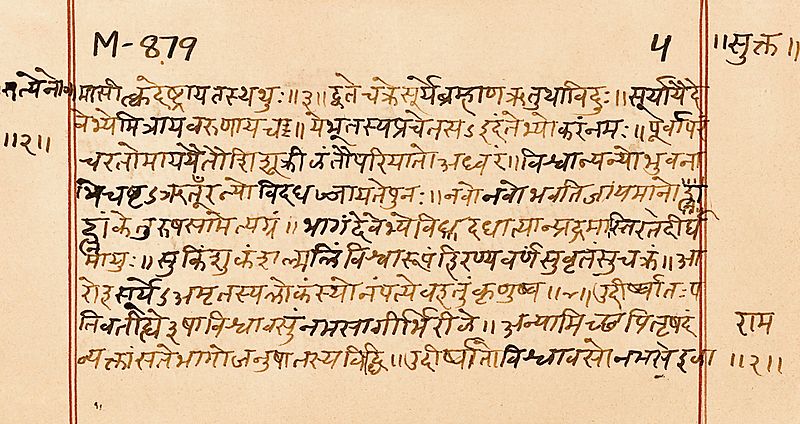Image: 1500-1200 BCE, Vivaha sukta, Rigveda 10.85.16-22, Sanskrit, Devanagari, manuscript page

Description: The Vedas are scriptures of Hinduism. The Rigveda samhita is dated between 1500 to 1200 BCE, while the others to between 1200 and 1000 BCE. Each Vedic samhita consists of books. These texts are in the archaic Sanskrit language and include four layers of texts, samhita being one layer of the Vedas. They contain hymns that cover a wide mix of topics: benedictions, mythologies, questions and riddles, the methodology for yajna sacrifices, potions and incantations, drama and poems, samskara (rites of passage verses), philosophy and mystical speculations. The hymns are set in the form of dialogues, dramatic play, or pedagogic style. The corpus of Vedic texts, as well all post-Vedic texts, are generally accepted to have been orally transmitted from generation to generation for over a millennium, till about the start of the common era. In Sanskrit, they were written in many Indic scripts. The scripture was written on palm leaf manuscripts, copied for preservation in Hindu temples and monasteries. Later paper and cloth versions were produced, where the page size was similar to the heritage palm leaf-like long pages. The above image is from Mandala 10, Hymn 85, of a northern recension of the Rigveda manuscript. It shows the Vivaha sukta, the celebrated hymn that continues to be in use for Hindu weddings. (see: Swami Vivekananda Bharata Press Prabuddha Bharata: Or Awakened India, pp. 362, 594 ) In the Rigveda it is verses 10.85.16 – 10.85.21 (also partially 10.85.15 and 10.85.22, for additional verses see 1500-1200 BCE, Vivaha sukta, Rigveda 10.85.16-27, Sanskrit, Devanagari, manuscript page.jpg). The text reads: द्वे ते चक्रे सूर्ये ब्रह्माण ऋतुथा विदुः । अथैकं चक्रं यद्गुहा तदद्धातय इद्विदुः ॥१६॥ सूर्यायै देवेभ्यो मित्राय वरुणाय च । ये भूतस्य प्रचेतस इदं तेभ्योऽकरं नमः ॥१७॥ पूर्वापरं चरतो माययैतौ शिशू क्रीळन्तौ परि यातो अध्वरम् । विश्वान्यन्यो भुवनाभिचष्ट ऋतूँरन्यो विदधज्जायते पुनः ॥१८॥ नवोनवो भवति जायमानोऽह्नां केतुरुषसामेत्यग्रम् । भागं देवेभ्यो वि दधात्यायन्प्र चन्द्रमास्तिरते दीर्घमायुः ॥१९॥ सुकिंशुकं शल्मलिं विश्वरूपं हिरण्यवर्णं सुवृतं सुचक्रम् । आ रोह सूर्ये अमृतस्य लोकं स्योनं पत्ये वहतुं कृणुष्व ॥२०॥ उदीर्ष्वातः पतिवती ह्येषा विश्वावसुं नमसा गीर्भिरीळे । अन्यामिच्छ पितृषदं व्यक्तां स ते भागो जनुषा तस्य विद्धि ॥२१॥ उदीर्ष्वातो विश्वावसो नमसेळा महे त्वा । अन्यामिच्छ प्रफर्व्यं सं जायां पत्या सृज ॥२२॥ Ralph Griffith's translation: (Wikisource) 16. The Brahmans, by their seasons, know, O Surya, those two wheels of thine: One kept concealed, those only who are skilled in highest truths have learned. 17. To Surya and the Deities, to Mitra and to Varuna. Who know aright the thing that is, this adoration have I paid. 18. By their own power these Twain in close succession move; They go as playing children round the sacrifice. One of the Pair beholdeth all existing things; the other ordereth seasons and is born again. 19. He, born afresh, is new and new for ever ensign of days he goes before the Mornings Coming, he orders f6r the Gods their portion. The Moon prolongs the days of our existence. 20. Mount this, all-shaped, gold-hued, with strong wheels, fashioned of Kimsuka and Salmali, light-rolling, Bound for the world of life immortal, Surya: make for thy lord a happy bridal journey. 21. Rise up from hence: this maiden hath a husband. I laud Visvavasu with hymns and homage. Seek in her father's home another fair one, and find the portion from of old assigned thee. 22. Rise up from hence, Visvavasu: with reverence we worship thee. Seek thou another willing maid, and with her husband leave the bride. These manuscripts are preserved at the Lalchand Research Library, Ancient Indian Manuscript Collection, DAV College Digital Library Initiative, Chandigarh India, in association with SP Lohia and Indorama Charitable Trust. The text is over 3000 years old, the re-copying into this particular manuscript is a pre-1890 reproduction. The manuscript shows stain marks, decay and damage on the sides and its edges. Language: Sanskrit Script: Devanagari Script style: pre-14th century (Northern / Western) ऋग्वेदसंहिता । The photo above is of a 2D artwork of a text that is over 3,000 years old, from a manuscript that was produced decades before 1923. Therefore Wikimedia Commons PD-Art licensing guidelines apply. Any rights I have as a photographer is herewith donated to wikimedia commons under CC 4.0 license.
Title: 1500-1200 BCE, Vivaha sukta, Rigveda 10.85.16-22, Sanskrit, Devanagari, manuscript page
Credit: Own work
Author: Ms Sarah Welch
Usage Terms: Creative Commons Attribution-Share Alike 4.0
License: CC BY-SA 4.0
License Link: https://creativecommons.org/licenses/by-sa/4.0
Attribution Required?: Yes
Image usage
The following page links to this image:

